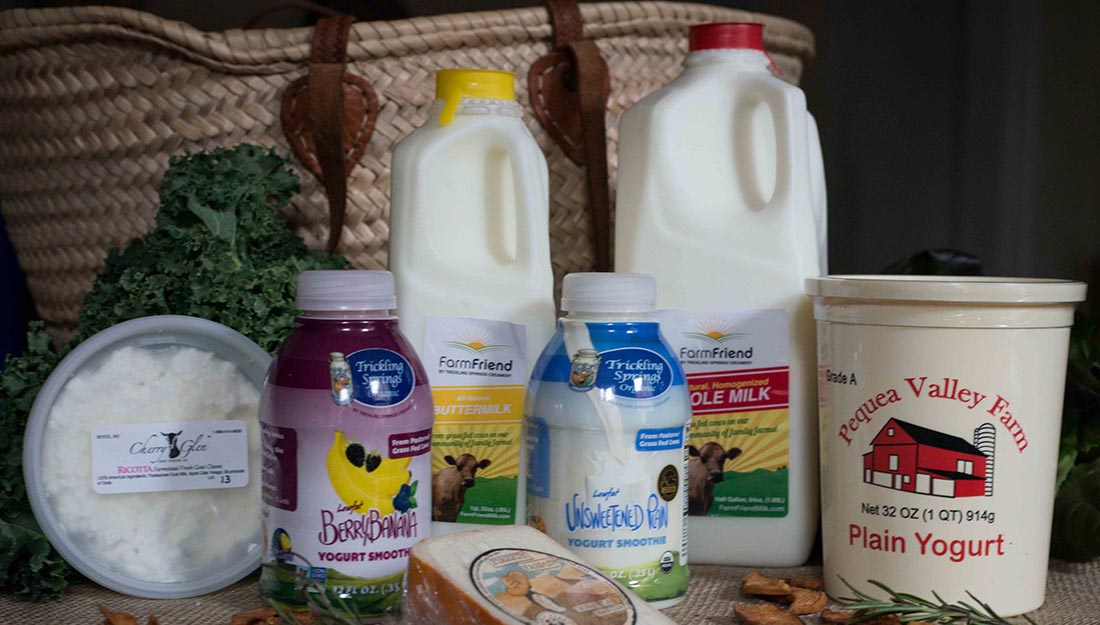Trickling Springs Creamery

As you step into the farm store at Trickling Springs Creamery in Chambersburg, Pennsylvania your eyes can’t help but feel hungry at the sight of local ice cream, yogurt, milk, homemade butters and jams and local cheese. The ladies behind the counter greet you as if you’ve always been a customer there forever, and behind the glass window you can see how the milk you’re about to drink was turned from the raw into its final bottled product. This speaks volumes of Trickling Springs, who have an open door policy and believe in complete transparency.
Trickling Springs in an essential part of the dairy farmers community in Chambersburg and beyond. They provide the infrastructure to turn raw grass-fed milk into the final product, and pay farmers a fair price for their milk. Trickling Springs has allowed many dairy farmers in the area to switch from conventional to organic, grass-fed farming by supporting them and giving them the wages they deserve.
Chris Horn was nice enough to set us up with a tour of the facilities, and the team got to wear super sexy hairnets and shoe covers as we made our way around. First stop: the bottle storage room. 70% of Trickling Springs’ bottles are glass, in an effort to reuse them as much as possible and decrease their environmental footprint. They have two product lines: Certified Organic ands Farm Friend. The milk their Farm Friend line comes from their local partners who are not quite certified organic yet, but they are in the process and will be soon. All of the milk comes from grass-fed cows, making it richer in vitamins and nutrients than the milk from conventional grain-fed cows.
The bottles are sorted, washed in hot water and then sent through a sanitizing rinse, so they can be reused and refilled with fresh milk. Did you know one of Trickling Springs glass bottles will save approximately FORTY plastic containers from the landfill?
First, Trickling Springs picks up the raw, grass-fed milk from its surrounding family farm partners, such as the Hamilton Heights Dairy Farm run by Cliff and Maggie Hawbaker.
Then, the milk is pasteurized using a High Temperature Short Time pasteurizer. Even though it’s called a High Temperature pasteurizer, at Trickling Springs it’s often referred to as “low-temp” pasteurization. This is because the milk is heated up to 160 – 165 degrees Fahrenheit, which is approximately 114 degrees less than the temperature most conventional milk is heated to. Other commercial dairies “cook” their milk to achieve a long shelf life of 60+ days so that it can be shipped across the country. Trickling Springs Creamery’s goal is to bring you the freshest, healthiest and best tasting milk available, which is why they use a lower temperature pasteurization. It still kills the bacteria, but allows most of the proteins, natural enzyme structures and nutrients to remain alive and whole. This is why their milk only has a 14-21 day shelf life.
The next stop for the milk is the cream separator. Trickling Springs still uses the old technology of spinning the milk and allowing the lighter cream to spin off of the top, separating the milk fat (cream) from the skim milk. When the milk comes to the homogenizer, the milk fat (cream) is broken into small particles to force the cream to remain suspended in the milk. Here the milk is forced with high pressure through fine screens which break the fat molecules down. This process was introduced in the late 1800’s to standardize milk flavors, and make milk easier to drink and handle, since it prevents the cream from separating.
From this point the milk is stored in large storage tanks until the milk is ready to be bottled or turned into another product, such as chocolate milk. The skimmed off cream is then used to be bottled into heavy cream or churned into butter and ice cream.
The reason Trickling Springs’ butter is more yellow than the usual grocery store kind is because of its high fat content, 91% compared to the typical 80%. Another contributing factor to the butter’s rich yellow hue is that it’s made using an old fashioned batch butter churn, and that the milk comes from grass-fed cows. The milk that the cows produce comes from eating fresh grass during the summer, and stored grass during the winter, making the milk rich in vitamins and beta carotene.
If you are ever interested in visiting Trickling Springs yourself, it’s less than a 2 hour drive from DC. Monday through Thursday, the production team bottles milk in the production hall behind the store. Please note that the schedule is subject to change at any time. If you want to be assured of seeing production activity, Trickling Springs recommends that you call ahead (717-709-0711) to find out when they will be processing.